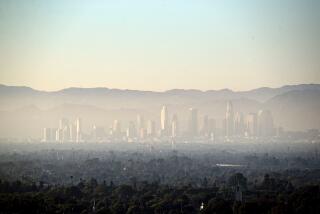EPA to Declare Passive Smoke Causes Cancer
- Share via
WASHINGTON — After months of furious debate, the Environmental Protection Agency will declare Thursday that secondhand smoke can cause cancer and is responsible for an estimated 3,000 deaths from lung cancer each year.
It also is expected to say that secondhand smoke aggravates asthma and other respiratory ailments and can be especially hazardous to children. But it will stop short of linking secondary smoke to heart disease.
Although the conclusions are not to be formally announced until a Thursday press conference by EPA Administrator William K. Reilly, word of the report set off another round of objections Tuesday from tobacco interests, which claimed that it is based on suspect science.
By formally declaring that secondary smoke is a potent carcinogen in a class with radon, asbestos and other established cancer-causing agents, the report is likely to provide impetus for efforts to further restrict smoking in the workplace and elsewhere--renewing the debate over the rights of smokers versus those of nonsmokers.
Already health groups and representatives of the tobacco industry have scheduled press conferences for today to respond to the EPA findings a full 24 hours before the report is formally announced.
The most bitter resistance to the EPA’s move to link secondary smoke and lung cancer has been waged by Philip Morris Cos., a leading cigarette manufacturer, and by the Tobacco Institute, the industry’s chief lobbying organization.
Some 30 years after the landmark surgeon general’s report on smoking and health, the industry continues to argue that there is no scientific proof of a link between cancer and smoking.
Health groups--among them the American Heart Assn., the American Cancer Society and the American Lung Assn.--said Tuesday that they are hopeful the EPA report will spur government action to curtail smoking in public places.
“Having the EPA’s imprimatur on this is extremely important,” said Dr. Alfred Munzer, a spokesman for the Coalition on Smoking or Health, which includes the Lung Assn., Heart Assn. and Cancer Society.
“We believe this will motivate state governments, local governments to enact further regulations limiting smoking in public places,” he said.
Munzer called on President Bush to use the report to justify an order to restrict smoking in federal buildings. “This is far less controversial than the pardons he has issued and would do a tremendous amount for the public health.”
Although the EPA has the authority to classify secondary smoke as a carcinogen, it cannot itself impose restrictions that would protect nonsmokers.
That role could fall to the Occupational Safety and Health Administration. A group called Action on Smoking and Health, which for more than two decades has carried on anti-smoking crusades, has sued OSHA in an attempt to force sharp restrictions or bans on smoking in the workplace.
In its report, the EPA is expected to say that secondary cigarette smoke can be especially harmful to children who are chronically exposed to it, increasing the risk of pneumonia, bronchitis and middle-ear disorders.
The report also will conclude that cigarette smoke increases the severity and frequency of asthma in children, EPA officials said.
It will estimate that secondhand smoke causes from 400 to 7,000 lung cancer deaths in American nonsmokers annually, resulting in an average of 3,000 such cases each year. The report will speculate, however, that the actual total could be much higher.
A second report that had linked secondhand smoke to 37,000 heart-disease deaths annually was withdrawn, according to Robert Axelrad, head of the EPA’s indoor-air division.
The link between cigarette smoke and heart disease is considered potentially even more explosive than the lung cancer link, because health officials have estimated that cigarette smoke causes roughly 10 times as many deaths from heart disease as from lung cancer.
The heart association has petitioned the EPA to do its own study of secondhand smoke and heart disease, but the agency has not yet responded. “We have not made a decision to do so at this time,” Axelrad said.
The report is one of the last major environmental declarations expected from EPA in the Bush Administration.
For much of the last four years, the agency has been at odds with the White House when its decisions have appeared to clash with economic interests.
More to Read
Sign up for Essential California
The most important California stories and recommendations in your inbox every morning.
You may occasionally receive promotional content from the Los Angeles Times.











